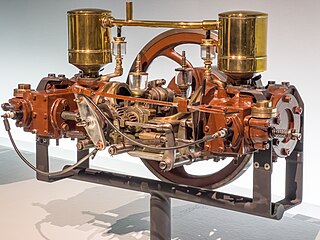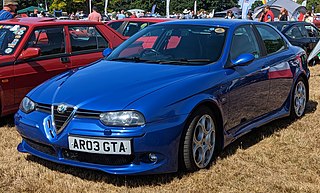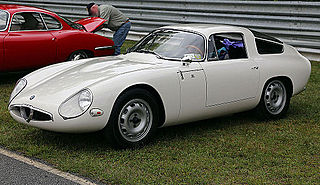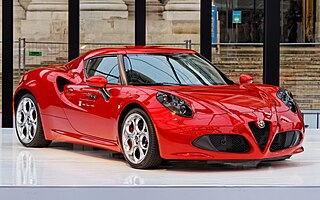
A sports car is a car designed with an emphasis on dynamic performance, such as handling, acceleration, top speed, the thrill of driving, and racing capability. Sports cars originated in Europe in early 1902 and are currently produced by many manufacturers around the world.

A flat engine is a piston engine where the cylinders are located on either side of a central crankshaft. Flat engines are also known as horizontally opposed engines, however this is distinct from the less common opposed-piston engine design, whereby each cylinder has two pistons sharing a central combustion chamber.

A flat-twelve engine, also known as a horizontally opposed-twelve, is a twelve-cylinder piston engine with six cylinders on each side of a central crankshaft.

The Alfa Romeo 156 is a compact executive car produced by the Italian automobile manufacturer Alfa Romeo. It was introduced at the 1997 Frankfurt Motor Show as the replacement for the Alfa Romeo 155. The 156 received a positive reception and in the following year went on to win the 1998 European Car of the Year award. The 156 saloon was discontinued in Europe late in 2005, while the Q4 Crosswagon continued in production until the end of 2007.

The Alfa Romeo Alfasud is a small family car manufactured and marketed from 1971 to 1989 by Alfa Romeo as a front-engine, four-door, five-passenger entry-level model over a single generation — with facelifts in 1977 and 1980. There was also a two-door sedan, only available in "ti" trim. Alfa Romeo subsequently introduced a three-door wagon variant, the Giardinetta (1975); two-door coupé, the Alfasud Sprint (1976); three-door hatchback (1981) and finally the five-door hatchback (1982).

The Jiotto Caspita is a prototype mid-engine sports car designed and manufactured by Dome in 1989. The car was billed as the "F1 on the Road." The original design of the car was done by Kunihisa Ito, who was the vice president and chief designer of Jiotto Design Incorporated. Its name is derived from the Italian exclamation "caspita".

The Alfa Romeo 1900 is an automobile produced by Italian car manufacturer Alfa Romeo from 1950 until 1959. Designed by Orazio Satta, it was an important development for Alfa Romeo as the marque's first car built entirely on a production line and first production car without a separate chassis. It was also the first Alfa Romeo offered with left-hand drive. The car was introduced at the 1950 Paris Motor Show.

The Alfa Romeo Nuvola is a concept car with coupé body first shown by Alfa Romeo at the Mondial de l'Automobile Paris motor show in 1996. Nuvola literally means "cloud" in Italian, but also hints to the legendary Italian racing driver Tazio Nuvolari. The Nuvola has a front-mounted engine and four wheel drive. The prototype is currently on display at the Alfa Romeo Historical Museum in Arese, Italy.
Pelland Engineering was a British engineering company that produced kit cars and made an attempt on the world land-speed record for steam cars.

Carlo Chiti was an Italian racing car and engine designer best known for his long association with Alfa Romeo's racing department. He also worked for Ferrari and was involved in the design of the Ferrari 156 Sharknose car, with which Phil Hill won the 1961 championship.
Factory Five Racing, Inc. (F.F.R.) is an American automobile company that designs and manufactures assembly kits, chassis, bodies and related components for replicars and sports cars.

The Alfa Romeo 8C Competizione is a sports car produced by Italian marque Alfa Romeo between 2007 and 2010. It was first presented as a concept car at the 2003 Frankfurt Motor Show. The name refers to the eight-cylinder engine (8C) and Alfa Romeo's racing pedigree. The company received over 1,400 orders for the 8C after the official announcement that the car would enter production. However, only 500 customers ended up with the 8C Competizione and another 329 with the 8C Spider, bringing the production total to 829 cars.

The Alfa Romeo Giulia TZ was a sports car and racing car manufactured by Alfa Romeo from 1963 to 1967. It replaced the Giulietta SZ. In 2011, the name was reduced from Giulia TZ to TZ in the new TZ3 model.

The Murtaya is a lightweight, all-wheel drive (AWD), turbocharged flat-4 roadster based on the GC-generation (1992–2000) Subaru Impreza WRX STi. The Murtaya is the only low volume MSA-approved category 2, specialist rally car currently available. The Murtaya Sports car is built, sold and is currently being further developed by ALS Sports Cars LLP, based near Tyne and Wear

The Subaru 1500 is the first car built by Fuji Heavy Industries, with the development code-name of P1. The prototype used a monocoque body structure and adopting the "ponton" style appearance, with an independent front wishbone suspension and a rear leaf spring suspension with three plates and a live rear axle.

The Alfa Romeo Tipo 512 was intended to replace the Alfa Romeo 158 Voiturette racing car. It was designed by Wifredo Ricart as his second car for Alfa Romeo after the V16 engined Alfa Romeo Tipo 162.

The Alfa Romeo 4C is a mid-engined sports car that was produced by Italian car manufacturer Alfa Romeo. Unveiled at the 2013 Geneva Motor Show, the 4C was initially only available as a coupé, with a spider body style coming a few years later in 2015. The name 4C refers to the straight-four engine.
Minari Engineering Ltd. was a Limited company based in Staffordshire, UK. They manufactured two vehicles, the Minari Club Sport, and the Minari Road Sport. They specialised in producing the components required to build cars based upon the Alfa Romeo Alfasud and 33 running gear, with bodies mainly constructed from GRP. These could either be purchased in Kit form or through a build agent, Chameleon Cars. Around 130 Mk2 kits were sold before production finally stopped in 2000.

The Alfa Romeo Tipo 103 is a sub-compact front-wheel drive automobile developed by Alfa Romeo in the late 1950s. A prototype powered by a 0.9 L double overhead cam inline-four engine was completed in 1960. Alfa did not put the Tipo 103 into production.

The Alfa Romeo Scarabeo is a concept car engineered by Giuseppe Busso and Orazio Satta Puliga for Alfa Romeo with a body designed by Sergio Sartorelli at Officine Stampaggi Industriali. The car debuted at the Paris Motor Show in 1966.
















